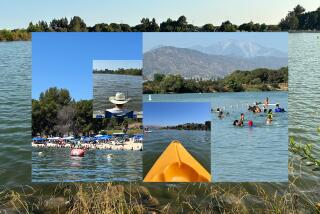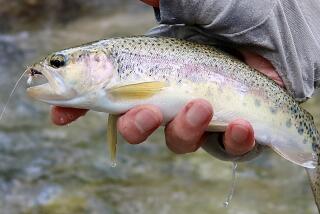Totally Tubular Fishing : Orange County’s Oso Reservoir Provides Lunker Bass to Floating Anglers
- Share via
Looking like a cartoon character, he waddles down the bank into the water, backward, with swim fins on his feet, a glorified inner tube around his waist and apprehension in his heart.
Tweedledum and Tweedledee couldn’t appear more absurd than a fisherman feels the first time he tries float-tubing. At Oso Reservoir in Orange County, it’s usually done at twilight or in the dim, predawn hours--not to avoid ridicule, the anglers claim, but because that is when the bass are biting.
Believe what you want. There was a time at Oso when the cover of darkness was prudent. Until 1988, fishing was illegal there, not to say unethical because most of the outlaw anglers practiced the conservation ethic of catch-and-release, and they didn’t pollute the water because it was already . . . well, sewer water.
The dam to create Oso was built by the Santa Margarita Water District in the late 1970s to store treated, reclaimed water for irrigating Mission Viejo’s golf courses, green belts and parks. When the city stocked Lake Mission Viejo with Florida largemouth bass, some extras were planted in Oso as a future supply.
The bass didn’t seem to mind their new environment. In fact, they thrived, and it didn’t take long for the fishermen to find out.
One, Mike Velleli of San Clemente, caught a largemouth that weighed 16 pounds 4 ounces. That he caught it in 1987, a year before fishing became legal at Oso, didn’t dampen the pride of his catch.
“He’s got it mounted,” said Bob Heerdt, president of the Oso Fishing Assn.
There were reports of 20-pound bass, but Velleli’s catch stands as the lake record because no one has admitted catching one larger--at least during the outlaw era.
The association was formed out of the desperation of the water district and the inspiration of the anglers. While the fishermen were doing no harm, they were trespassers who could become a liability nightmare. The water district once had 30 arrested.
Bill Knitz, manager of the water district, said a chain-link fence was considered, until it was determined that the cost would be $500,000 to enclose the 2 1/2-mile circumference of the reservoir.
“And even then, some people would find a hole or just climb over,” Knitz said.
Security guards also would be expensive, and besides, Knitz said, “We didn’t want to get into the police business. We were in the reclaimed-water business.”
Another option was to eliminate the attraction by eliminating the fish.
“But we didn’t want to poison all the fish and put up signs saying, ‘Don’t bother coming in, there’s nothing here,’ ” Knitz said. “It would still be an attractive nuisance.
“So we said, ‘Why don’t we get a group of guys who want to go up there and fish--maybe some of the same guys that are poaching--and start a fishing club?’ They’ll give us 24 hours-a-day security in return for letting them fish the lake.”
One night in the lounge at Coto de Caza, Knitz approached Heerdt, an acquaintance whom he suspected of seeking Oso bass occasionally. Would Heerdt and his clandestine companions be interested in going straight?
“We were drinking some beers when I mentioned it to him,” Knitz said. “A month or two later, he called me up and said, ‘I’d like to talk to you about it.’ ”
Heerdt, a semi-retired accountant, went to work forming the association, which now has about 160 members, with a goal of 200.
The lease is free, but the liability is extraordinary, and the association’s end of the deal is to pay the insurance premiums that cost up to $35,000 a year. Heerdt credits Thad Smith, an insurance agent who is a member, with finding affordable rates.
Heerdt said the water district warned him: “Don’t you ever let us catch one of those guys wet, or there’s going to be problems. You can’t touch the water.”
No water-contact sports are allowed, and float tubers must wear chest waders, as they are required to do on reservoirs that supply drinking water. In this case, the rule is to protect them from the water, although Knitz says the water is treated to such a degree that “you could do everything (safely) but drink it.”
The arrangement, Knitz said, has “worked out perfectly.”
“It’s turned out to be a win-win deal for everybody,” Heerdt said. “The water district is happy because now they’ve got security . . . people watching the lake for them. And the fishermen are winning.”
Heerdt is one of only three paid employees of the association, along with Danny Taylor and Brian Wagner, who handle maintenance, security and construction. Trees will be planted. A clubhouse is being built on a bluff above the west shore.
“It’ll be a wildlife museum and a library,” Heerdt said. “We’d like to think we’re patterning this after the fly-fishing clubs along the River Trent in England. That’s the kind of clubhouse we’d like to have--and members who are conservation-oriented. This isn’t work. We’re creating something here.”
Oso--90 feet at its deepest point--also has California northern bass, bluegill and catfish but is total catch-and-release for bass.
“It doesn’t appeal to the guy who wants to fish all day with worms and take the fish home and eat them,” Heerdt said.
But it’s ideal for fly anglers, who never keep anything they catch, or wouldn’t admit it if they did.
A membership costs $1,000 a year, but members can reduce that to as low as $600 through programs with the Joplin Boys Ranch in Trabuco Canyon and other youth facilities. Any member who takes a youngster fishing for a day gets $100 credit on his dues, $50 for half a day.
If a youth released from a disciplinary facility stays out of trouble for two months, he is given a rod and reel and free fishing privileges. Heerdt believes the program has turned some lives around.
Non-members may fish for $40 a day. About one-fourth of the fishermen are float-tubers, and virtually all use flies. Half of the members have boats, although no outboards--only electric trolling motors--are allowed. Most of the boaters spin-fish with lures. No live bait is permitted.
Oso is in a valley a few miles up El Toro Road from the San Diego Freeway, past the residential developments and directly under the takeoff flight path of the fighter jets from the El Toro Marine Corps Air Station. The “sounds of freedom,” as Knitz, a former carrier pilot, calls them, even drown out the 14 species of ducks, whose quacking and whistling sometimes is so loud that “you can’t hear yourself talk,” Heerdt said.
Oso doesn’t look like a sewer. It doesn’t even smell like one, not even from a float tube, which suspends an angler half in the water and half out.
“This lake was made for float-tubing,” Heerdt said.
From a tube--also called a “belly boat”--an angler can paddle himself quietly along the weedy shoreline where the bass lurk, casting as he goes. Skip Conrad, the noted fly fisherman, prefers tubes to boats.
“It’s more comfortable,” he said while bobbing along Oso’s north shore. “I can get to where I want and cover the water better. You can hunt bass better than in a boat . . . sneak up on them and get closer. You’re not making any noise.
“And you don’t have to buy a $20,000 bass boat. The only thing I don’t have is (an electronic) fish locater.”
Conrad doesn’t need one. His senses seem to penetrate the murky water near the shoreline to find bass where others might pass by.
“Skip is the best fly fishermen here,” Heerdt said, “but he’s going to have some real competition with a local kid by the name of Tracy Ickard.”
An angler who hasn’t float-tubed has to make only minor adjustments--such as learning how to walk into the water.
One of Conrad’s companions is Dick Thies of Long Beach, a lifetime fly angler who pioneered float-tubing on Lake Shasta with an old inner tube that had a rope for a seat. Nowadays, some have pockets to store equipment, clothing or lunch.
Conrad, who manages Bob Marriott’s fly-fishing store in Irvine, said the proper tackle is the only other important consideration.
“A big mistake a trout fisherman will make, he’ll go bass fishing with too light a rod and too light a tippet. Every bass they hook they’ll lose.”
For Oso, Conrad advises 15- to 20-pound tippets, as well as heavy-duty gear.
“It’s best to have a long rod when you’re float-tubing, say a nine-foot up to a 10-foot,” he said. “It keeps your back-cast high.”
Conrad is fishing in the evening, although he prefers mornings. Two men drift past in a bass boat.
“How you doing?” Conrad asks.
“Unbelievable,” one says. “We lost count, we got so many.”
Conrad isn’t swayed. He promises even better fishing in the morning.
“Most lakes, right around the last 45 minutes before dark, generally there are bass in the shallows and you can do real good on poppers. But this lake, I never had luck doing that. Other lakes I’ve fished--Moreno, Henshaw--are all pretty good in the evenings. Why this lake isn’t, I don’t know.”
But to Conrad’s uninitiated companion, it isn’t bad on this evening. As swallows dart about, scooping insects out of the air, the first-time float-tuber thinks he has cast into a snag a couple of feet from shore--until the snag starts to move. A three-pound bass leads him around in circles, spinning the tube, then wraps the line around a heavy twig sticking out of the water.
Thies paddles over and lifts the twig, freeing the line. The bass is still on and soon in hand.
But it is even better in the morning. The group is back on the water, in the dark, by 5:15 a.m. At 6:15, another float-tuber, Mike Field of El Toro, drifts by and says he has already had 17 catches. Conrad will have “13 or 14” until the bite suddenly stops at about 7.
“Early in the morning, the bass will be right in against the shoreline because that’s when the bait comes in there,” Conrad said. “As it gets later, they move out into five or 10 feet of water because the bait moves out and the bass follow it, and we’d use wet flies. So you throw poppers or things like that early in the morning or late in the evening.”
Even when hatches of Chironomus midges are swarming along the shore by the thousands, Conrad prefers to use bass bugs or floating poppers made of balsa wood, plastic or spun deer hair. This day, he is using the last one.
“The reason I like to use hair bugs is they’re easier to cast on a fly rod. A solid body bug kind of feels like a weight hanging out there, and I have a feeling that a bass will hang onto a hair bug longer, if you’re slow in striking, than they will with a hard-body bug. It feels more natural.”
Some trout anglers--especially devoted fly anglers--regard the bass as only slightly above the lowly carp on the social scale of fish.
“It’s amazing what they’re missing, especially in Southern California,” Conrad said. “We have more good bass fishing here than trout fishing.”


